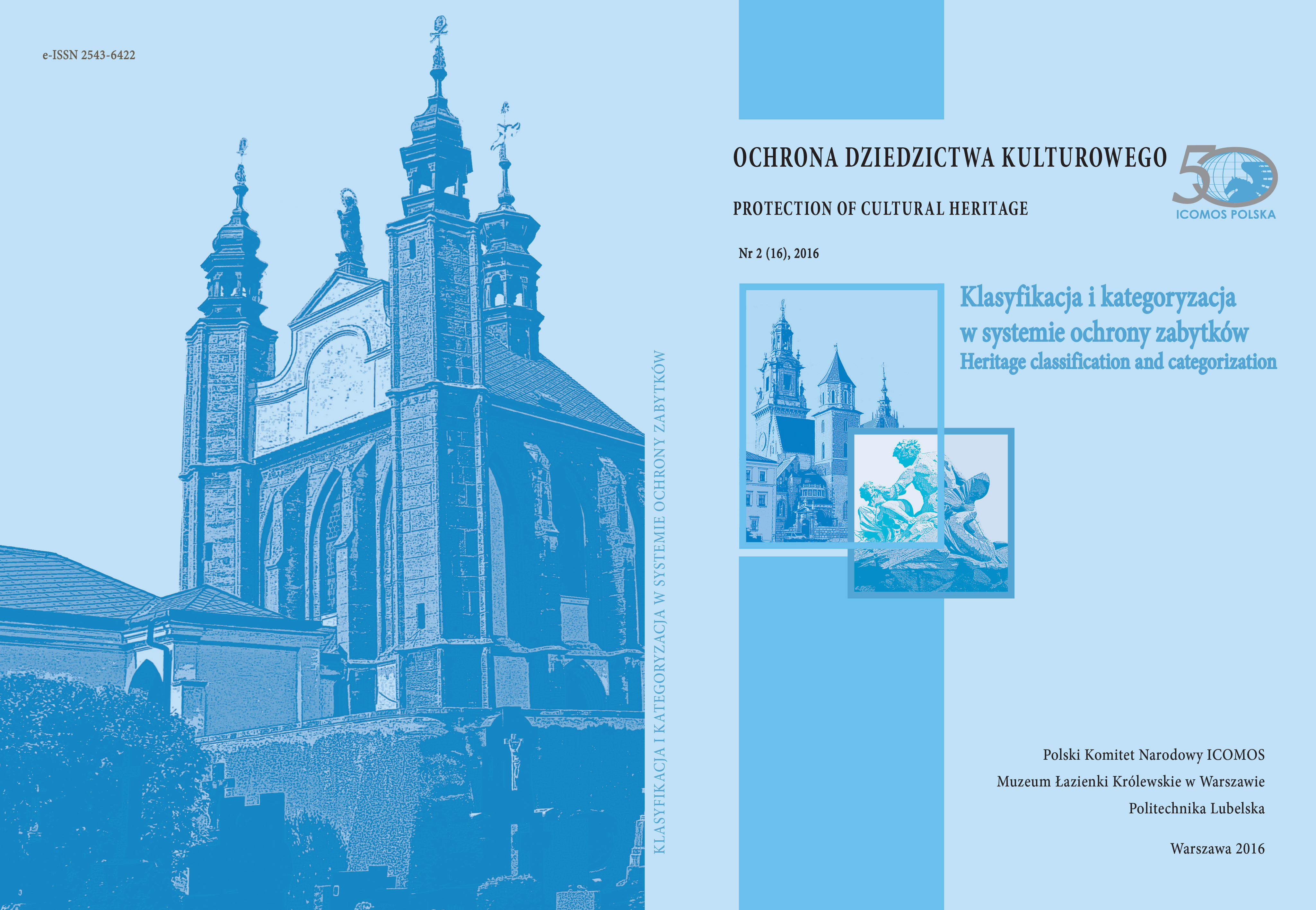Classification of monuments in Czech legislation
Article Sidebar
Open full text
Issue No. 2 (2016)
-
Classification of monuments in Czech legislation
Monika Dąbkowska7-13
-
Can Wawel be superstructed? Reflections on the classification of monuments
Jacek Dąbrowski, Dariusz Jankowski15-26
-
Historic value measured in meters. Protection of monuments in the context of the Act on the Protection of Monuments and Protection of Monuments and the Construction Law
Helena Jadwiszczok-Molencka27-40
-
Cultural landscape as a category of monuments and its specificity
Lidia Klupsz41-56
-
Value assessment - a necessary stage for the protection of archaeological monuments
Marek Konopka57-66
-
Conservation works and the classification of monuments
Małgorzata Korpała67-78
-
Qualification of the value of the monument in the light of the law of the United States of America
Wojciech Kowalski79-90
-
On the beginning of the classification of monuments. On the advantages and disadvantages of Polish heritage valuation systems
Jakub Lewicki91-108
-
Pontiseum - a collection of historical exhibits that are outside the classification of monuments
Barbara Rymsza, Anna Mistewicz109-116
-
List of historic elements as a tool for valorization of a monument in the process of classification and categorization
Piotr M. Stępień117-119
-
Classification and categorization in the system of monument protection
Bogusław Szmygin121-132
-
Are monuments of technology and engineering in Poland still a “second-class” heritage? Historical outline and current problems
Bartosz M. Walczak133-144
Main Article Content
DOI
Authors
Abstract
In Czechia, provisions of law pertaining to historic preservation were established in 1958, during Stalinism. The regulations were provided in Czechoslovakian Act on Cultural Monuments.
It was superseded by the Act on State Care for Historic Monuments and Sites being currently in force, which was adopted in the former political system in 1987. Due to dynamic economic, political, and ownership-related transformations taking place at that time, it was necessary to amend it. Consequently, for several years, the legislators have been working on a new act referred to as “The Act on Protection of Resources of Historic Monuments and Sites.” This article pertains to legislative solutions and classification of historic monuments and sites in the light of the Act being developed. In this document, historic monuments and sites are not grouped into specific categories. Instead, they are all considered material elements of cultural heritage. On the other hand, assets of historical significance are classified into cultural monuments, monument ensembles, and national culture monuments and sites of the most outstanding significance. Additionally, two temporary forms of historic preservation have been developed: areas and reserves of historical significance. Archaeological monuments and properties considered as having outstanding historical values under certain international agreements are treated separately. This classification allows for assigning tasks to appropriate administrative bodies and, at the same time, encouraging institutions responsible for historic preservation of monuments and sites on the national level to become advisory bodies of regional administration institutions. What is worth mentioning in the field of historic preservation in Czechia are government’s attempts at making historic monuments and sites more available to citizens by introducing certain legal regulations, i.e. providing the government with pre-emptive right to purchase
a property of historical significance from a private owner. This approach results in increasing government’s profits from tourism and culture-related products.
Keywords:
References
České dráhy pro vás, Nr 4/2012.
Zákon o státní památkové péči, 1987.
Article Details
Monika Dąbkowska, Faculty of Architecture, Wroclaw University of Technology
dr, Wydział Architektury Politechniki Wrocławskiej. Konserwator-zabytkoznawca. Zainteresowania badawcze: architektura sakralna i problematyka konserwatorska, budownictwo cysterskie na Śląsku, prawne aspekty ochrony zabytków. Autorka kilkunastu artykułów naukowych o tematyce historycznej, zabytkoznawczej i prawnej. Absolwentka Podyplomowego Studium Administracji Publicznej na Wydziale Prawa UMK w Toruniu, pracownik administracji terytorialnej w zakresie ochrony zabytków.






